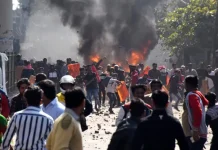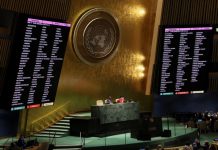Armenia and Azerbaijan have been engaged in an active conflict for at least a week now, with both sides accusing each other of initiating deadly attacks. The skirmishes are centered around the disputed territory of Nagorno-Karabakh, which exists as an autonomous enclave within Azerbaijan but run by ethnic Armenians. The international community officially recognizes it as a part of Azerbaijan.
History of Current Conflict
Since 1994, the conflict lay dormant; before that, the two former Soviet republics fought two wars over it, eventually reaching a cease-fire without any diplomatic resolution. But the actual roots of the conflict lie in the mid-18th century. Under Safavid Iran, Karabakh gained a semi-autonomous status as a Khanate with Armenian royalty, which was annexed by the Russian empire in 1813 under the Treaty of Gulistan, and in 1822 all Armenian princes lost their royal titles. Karabakh’s population saw themselves as an autonomous Armenian community fighting off invasions by Azerbaijan and the Ottoman Empire after the Fall of the Trasdom in Russia. Both of the newly formed states, Azerbaijan and Armenia, laid claim to the territory, with Armenia providing limited assistance to Karabakh. After the dissolution of the Ottoman Empire, the British merged Karabakh (Artsakh) into Azerbaijan. The Soviet Army soon overtook the majority of Azerbaijan, and over two years of political instability, Karabakh tried to unite with Armenia before USSR annexed both. The soviets established Nagorno-Karabakh Autonomous Oblast (NKAO) within the Azerbaijan SSR, recognizing the region’s autonomy but as part of Azerbaijan.

With the Fall of the USSR in 1991, the territories were already engaged in a war since 1988, which lasted till 1994. This conflict led to major regional powers taking sides, with Azerbaijan supported by Turkey (both are Turkic Muslim majority nations) and Israel and Ukraine. And the newly formed Russian federation providing some arms to Armenia (some reports claim Russia sold weapons to both sides of the conflict). This conflict ended in the de facto autonomous region of Nagorno-Karabakh and its unification with Armenia, and the de jure recognition of Nagorno-Karabakh as part of Azerbaijan. This situation remains the same till today.
According to the 2018 war report prepared by the Geneva Academy of International Humanitarian Law and Human Rights, “Armenia exercises its authority over Nagorno-Karabakh by equipping, financing or training and providing operational support to the self-proclaimed Nagorno-Karabakh Republic and its forces, but also in coordinating and helping the general planning of their military and paramilitary activities.” For three decades, multiple ceasefire violations have occurred, the most serious being the 2016 Nagorno-Karabakh clashes.
Regional Politics
Turkey and Armenia have deep historical animosities, with the Armenian genocide’s backdrop making Armenia the natural ally of the Kurdish nationalist movement. With Turkey expanding its role in the region with active involvement in Syria, Iraq, and Greece, many warn Turkey is heading to an expansionist part. Such development is visible with Erdogan’s policies at home that are premised on a distinct brand of Turkish religious nationalism, the Neo-Ottomanism. Turkey has taken an active role in this conflict by charging its public against Armenia and calling the narrative of “One Nation, Two States” to aid its ethnoreligious ally, Azerbaijan.
On the converse, claims of helping and bringing the Kurdish fighting forces into the conflict are surfacing against Armenia. On the converse, France got involved with condemning Turkey and Azerbaijan. The French President said intelligence reports had established that 300 fighters from jihadist groups in Syria had passed through Turkey en route to Azerbaijan, saying that “a red line has been crossed” and demanding an explanation. Furthermore, Macron urged the EU to pay closer attention to Turkey’s role in the Mediterranean, hinting towards the Neo-Ottomanist policies of Erdogan. Turkish government reacted with harsh statements, after which France urged both sides to engage in peaceful dialogue. Russia has been consistent with its historical policy as it extended support to Armenia. Russia considers Armenia to be a strategic ally and has a military airbase in Armenian territory. The Russian foreign ministry also released a statement alleging that combatants from Lybia, Iraq, and Syria from illegal armed groups were being sent to Nagorno-Karabakh.
Current Situation
As of now, both sides reported military and civilian casualties. In response to the clashes, Armenia and the self-proclaimed Republic of Artsakh introduced martial law and total mobilization, while Azerbaijan introduced martial law and a curfew. On 28 September, partial mobilization was declared in Azerbaijan.
Reports from the ground are less and mostly from official statements from the states involved, which put them more in the realm of politics and narrative building and less so in the realm of facts. Azerbaijan’s Ministry of Defense has been very active in releasing information to the media along with some footage. At 01:10, the Azerbaijani MoD released footage claiming to show the destruction of Armenian material, and later, claimed the neutralization of several Armenian air defense assets and multiple launch rocket systems. Azerbaijan was also employing drone attacks in Armenian territory and reported that Armenia has shot down one UAV (Unmanned Ariel Vehicle), confirming that Azerbaijan has been invading into Armenian airspace.
After France, the USA, the United Nations, and other powers have pushed for a diplomatic solution to the dispute. Turkey, on the other hand, has maintained that it respects Azerbaijan’s right to self-defense. Armenia’s foreign ministry has said it “stands ready to engage” with France, Russia, and the US on halting six days of fighting with its neighbor Azerbaijan.









